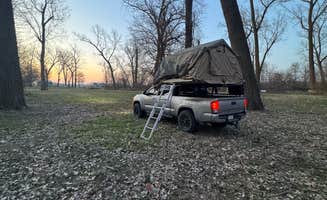Hoot Owl Bend offers dispersed camping near Hamburg, Iowa in a minimalist setting along the Missouri-Iowa border. The site sits in a flat floodplain area with cottonwood trees providing limited shade during summer months. Winter camping remains possible but unprotected from wind conditions that regularly sweep across the open areas. The temperature range varies dramatically throughout the year, with summer highs regularly exceeding 90°F and winter lows frequently dropping below freezing.
What to do
Bird watching opportunities: The clearing at Hoot Owl Bend provides habitat for various bird species. "This spot would be great for bird watchers," notes reviewer Donner N., who recommends bringing binoculars for wildlife spotting.
Avoid mulberry trees in summer: When setting up camp during July, select your tent location strategically. According to a camper, "One of those trees in a mulberry, don't put your tent under it you will have mulberries dropping on you in July."
Night photography sessions: The minimal light pollution makes this area suitable for astrophotography. The clearing provides unobstructed sky views for stargazing activities, though campers should come fully prepared with all necessary equipment.
What campers like
Basic overnight accommodations: Some campers appreciate the site's simplicity for quick overnight stays. "Good enough for a place to lay your head at least. I used a pickup truck with a tent and nobody bothered me," shares Carter G. from Hoot Owl Bend.
Wildlife encounters: The area supports active nocturnal wildlife. One camper reported, "I did hear animals huffing and saw some shadows run next to the truck at like 2am haha."
Accessible clearing: The flat, open terrain makes tent setup straightforward. A visitor mentioned, "A nice little clearing easy to set up a tent in," highlighting the practical layout for basic camping setups.
What you should know
Confusing access signage: Visitors report uncertainty about permissible camping hours. "Sign says area closed 10pm-4am, so camping of any kind seems unallowed," warns Gordy Y., suggesting potential restrictions campers should investigate before arriving.
No established facilities: The site completely lacks developed amenities. As one camper notes, "There also is no fire pit or amenities at this site," requiring visitors to bring all necessary equipment including portable toilets and water containers.
Vegetation hazards: Walking paths toward water access contain natural hazards. A camper advises, "There is a nice walk towards the water, just wear pants and closed shoes to avoid the stinging nettle," suggesting proper clothing for exploration.
Tips for camping with families
Bring complete meal supplies: No food preparation facilities exist on site, requiring families to pack cooking equipment, fuel, and all food items. The remote location means no nearby markets or convenience stores for forgotten items.
Pack extra water containers: With no potable water source, families should calculate minimum water requirements of 1 gallon per person per day, plus additional water for cooking, washing, and emergency reserves.
Prepare for bathroom logistics: Families with young children should bring portable toilet facilities and proper waste disposal containers. The lack of sanitation infrastructure requires careful planning for multi-day stays.
Tips from RVers
Limited turning radius: The access road and clearing size restrict larger recreational vehicles. RVs exceeding 25 feet may experience difficulty maneuvering within the available space, especially during wet conditions when ground may be soft.
Self-contained systems required: With no hookups available, RV campers must rely entirely on onboard systems. Plan for limited stays based on black/gray water tank capacity and bring sufficient drinking water reserves.
Leveling challenges: The natural terrain may present leveling difficulties for RVs. Bringing sturdy leveling blocks is recommended as the clearing contains natural depressions and uneven areas throughout the camping zone.


